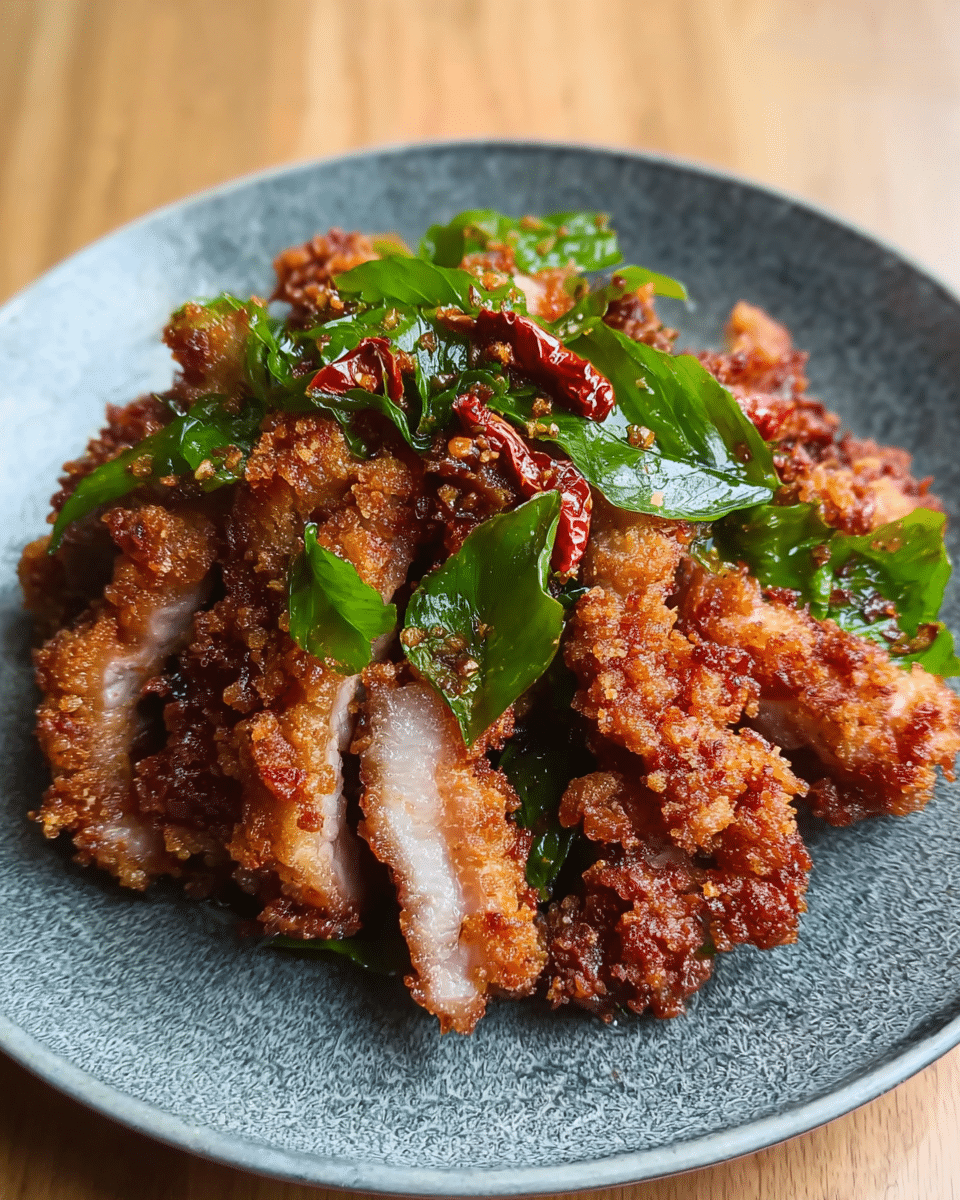This dish is inspired by the Moo Klook Foon from Soi Geneva, a Thai restaurant known for its unique and flavorful offerings. It combines the textures and concept of Thai crispy marinated pork, but with a twist using the Taiwanese “fried chicken breading” technique. The result is succulent, juicy pork with a crunchy coating and a slight numbing spice from Sichuan peppercorns, creating a delightful combination of flavors and textures.
Full Recipe:
Ingredients
-
1/4 tsp ground Sichuan peppercorns (and more for garnish)
-
1 tsp fresh ginger, grated finely
-
2 cloves of garlic, smashed
-
2 tbsp tamari or regular soy sauce
-
1/2 tbsp rice vinegar
-
530g pork steak, cut into 1-2 cm strips
-
3/4 cup (89g) tapioca flour
-
1 cup fresh Italian or Thai basil leaves, completely dry
-
Neutral oil (for frying)
-
Salt (to taste)
Directions
-
Marinate the Pork: In a bowl, combine the ground Sichuan peppercorns, ginger, garlic, tamari (or soy sauce), and rice vinegar. Mix well. Add the pork strips, season with salt, and stir to coat the pork in the marinade. Cover and refrigerate for at least 2 hours, or overnight for more flavor.
-
Prepare for Frying: Remove the marinated pork from the fridge and let it come to room temperature. Heat neutral oil in a pot, filling it halfway.
-
Coat the Pork: Add the tapioca flour to the pork and mix with your hands until little beads form on the meat. These will turn crispy when fried. Heat the oil to 175°C (350°F).
-
Fry the Pork: Test the oil by dropping in a small piece of flour—if it sizzles and floats, the oil is ready. Add the pork pieces in batches to avoid overcrowding and dropping the oil temperature. Fry until the coating turns golden and the pork is fully cooked. Remove and place on a wire rack or paper-lined plate.
-
Finish the Dish: Once all the pork is fried, sprinkle it with salt and ground Sichuan peppercorns. Toss to evenly coat. In the hot oil, fry the basil leaves for 10-20 seconds until crispy, then remove and let them rest on paper towels.
-
Serve: Plate the fried pork and basil. Serve while hot and enjoy!
Estimated Nutritional Breakdown (Per Serving, assuming 4 servings)
-
Calories: 350–450 kcal
-
Protein: 28–32g
-
Carbohydrates: 25–30g
-
Fiber: 1–2g
-
Sugar: 1–2g
-
-
Fat: 15–20g
-
Saturated Fat: 3–5g
-
Monounsaturated Fat: 8–10g
-
Polyunsaturated Fat: 1–2g
-
-
Cholesterol: 60–80mg
-
Sodium: 700–900mg (depends on the soy sauce used)
-
Potassium: 400–500mg
-
Calcium: 30–40mg
-
Iron: 1–2mg
-
Vitamin A: 15–20% of the Daily Value (from basil)
-
Vitamin C: 5–10% of the Daily Value (from ginger and basil)
The Influence of Moo Klook Foon
Moo Klook Foon, a Thai classic, is beloved for its savory and crispy marinated pork. This dish is typically served with a flavorful, slightly spicy coating that contrasts perfectly with the tenderness of the pork. The inspiration behind this recipe draws from that concept but introduces a unique technique used in Taiwanese fried chicken to elevate the texture of the pork. By using tapioca flour as a coating and frying the pork at the right temperature, the result is a crunchy, light exterior that complements the juicy, flavorful meat inside. The addition of Sichuan peppercorns gives the dish a numbing sensation that enhances the spiciness and creates a new layer of complexity in the flavor.
Why Sichuan Peppercorns?
Sichuan peppercorns are a key ingredient in this recipe, adding a signature numbing and tingling effect known as “má” in Chinese cuisine. This unique sensation comes from the compound hydroxy-alpha-sanshool, which interacts with sensory nerves, creating a cool, numbing effect that enhances the spiciness of the dish. Combined with the ginger and garlic in the marinade, the Sichuan peppercorns work to elevate the overall flavor profile, adding an exciting twist to the familiar taste of crispy fried pork.
The Key Ingredients: Fresh and Flavorful
The ingredients used in this recipe are essential to creating the layers of flavor that define this dish. The pork steak, cut into thin strips, serves as the base and absorbs the marinade, becoming tender and flavorful. The tapioca flour is the secret to achieving the perfect crispy coating when fried, giving the pork an extra crunch without being too heavy.
Fresh Italian or Thai basil leaves bring an aromatic herbal element to the dish. When fried, the basil becomes crispy and adds an unexpected pop of flavor that perfectly complements the richness of the fried pork. The combination of soy sauce or tamari, rice vinegar, ginger, and garlic in the marinade infuses the pork with deep umami and fragrant notes that balance out the spice and tang of the Sichuan peppercorns.
Preparing the Pork: Marination for Maximum Flavor
The key to this dish’s success lies in the marination process. Combining Sichuan peppercorns, ginger, garlic, tamari or soy sauce, and rice vinegar creates a well-rounded marinade that will infuse the pork with rich, complex flavors. Allowing the pork to marinate for at least 2 hours, or overnight for even more depth, ensures that each piece absorbs the marinade and becomes tender and flavorful.
Frying: Achieving the Perfect Crunch
Once marinated, the pork is coated with tapioca flour. The tapioca flour gives the pork an incredibly light and crispy texture once fried, unlike traditional flour, which can sometimes result in a heavy, greasy coating. This method, inspired by Taiwanese fried chicken, ensures the pork stays juicy inside while getting a golden, crunchy exterior.
When frying, it’s essential to heat the oil to 175°C (350°F). This is the ideal temperature for frying the pork in batches. Adding the pork to the hot oil in small batches helps maintain the oil’s temperature, ensuring the coating crisps up without becoming soggy. Frying the pork until golden ensures a satisfying crunch with each bite, creating a delightful contrast between the crispy exterior and the tender interior.
Crispy Basil: A Flavorful Garnish
To elevate the dish further, fresh basil leaves are fried in the same oil used to cook the pork. The basil crisps up quickly, adding an additional layer of flavor and a vibrant green color to the dish. This fried basil not only enhances the taste but also gives the dish a beautiful visual appeal, making it a feast for both the eyes and the palate.
Finishing Touches: Adding Flavor and Spice
Once all the pork is fried to perfection, it’s time to finish the dish. The pork is tossed with salt and additional ground Sichuan peppercorns, ensuring that every piece is coated in the fragrant spice and the seasoning is evenly distributed. This final step adds a depth of flavor and a slight numbing heat that defines the dish.
Serving: A Perfectly Balanced Dish
When serving, the fried pork is plated with the crispy basil leaves, making it visually striking and full of flavor. The dish is best served while hot to enjoy the full contrast between the crispy pork and the tender, juicy meat inside. Pair it with a side of steamed rice or sautéed vegetables for a well-rounded meal. The aromatic Sichuan peppercorns and fried basil leaves provide an explosion of flavor that will have your taste buds tingling long after the meal is over.
Nutritional Breakdown: Flavor Meets Protein
This dish is not only delicious but also packs a solid amount of protein, thanks to the pork steak. Each serving provides approximately 28-32g of protein, making it a filling and satisfying meal. While the dish is rich in flavor and a bit indulgent, it’s balanced with healthy fats, such as monounsaturated fats from the oil and fat content in the pork. The fiber from the basil and the slight sweetness of the tapioca flour help to balance the richness of the dish, making it a satisfying meal that won’t leave you feeling overly full or sluggish.
However, it’s important to note the sodium content, which can vary depending on the soy sauce or tamari used in the marinade. If you’re concerned about sodium intake, opting for a low-sodium soy sauce or tamari can help reduce the sodium level in the dish.
Conclusion
This recipe offers a unique twist on a Thai classic by incorporating the Taiwanese fried chicken breading technique, resulting in a crispy, flavorful dish that combines succulent pork with numbing Sichuan peppercorns and aromatic basil. The careful balance of spices and textures makes this dish stand out, providing a delightful contrast between crispy and tender, savory and spicy. Whether you’re craving something bold and exciting or looking to try a new spin on a traditional Thai recipe, this fried pork with Sichuan peppercorns is a must-try.






